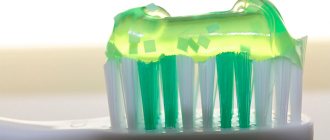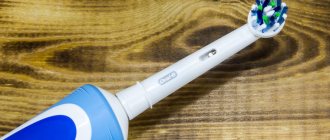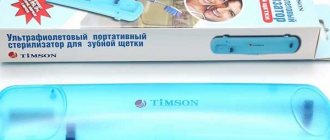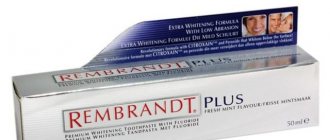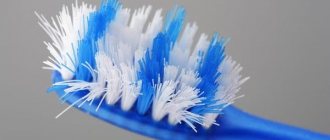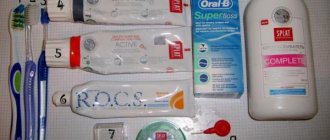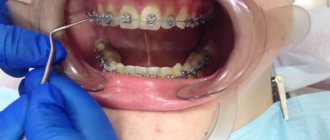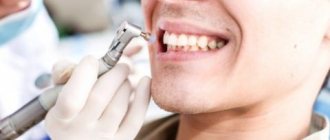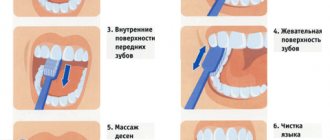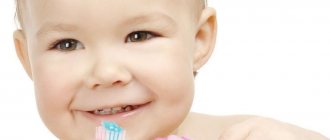17479
The braces system is considered one of the most effective methods of teeth straightening.
Wearing such systems often takes a long time, so the owner needs to learn how to properly care not only for the oral cavity, but also for the braces themselves.
The reasons for the deformation of such systems can be not only physical impact, but also the consumption of the “wrong” food.
Cleaning before braces: why is it needed?
Correction of the bite always begins with sanitation of the oral cavity. In addition to treating diseases of the teeth and gums, it includes mandatory professional cleaning before installing braces. The doctor will remove hard deposits with ultrasound, and soft deposits with a thin and powerful jet of cleaning powder solution (AirFlow technology). After this, the teeth will need to be polished with a special paste and coated with a fluoride-containing preparation to strengthen the enamel. Such a hygienic procedure should be carried out 3 - 5 days before installation, but no later than 24 hours.
What happens if you don’t brush your teeth before braces? Bacterial plaque will get under the elements of the system, in particular under the clasps that are glued to the enamel. Considering that orthodontic appliances are worn for a year at best, and two years on average, microorganisms will have enough time to multiply and lead to the formation of caries. It is impossible to properly cure it with braces on the teeth. There is a risk of early removal of the device, and this will spoil the final result, and the patient will waste money, time and moral strength. This is why brushing your teeth before getting braces is mandatory.
Ways and means
A person who encounters this system for the first time initially does not understand how to care for braces and teeth, what devices need to be used to avoid the occurrence of diseases of the teeth and gums.
The following dental devices are available.
- Special toothbrushes. During the period of teeth correction, it is necessary to use a special brush. There are two types of such brushes: V-shaped and mono-beam. The V-shaped brush is considered the most effective means of oral hygiene. This brush has a cutout in the bristles, due to which the bristles clean the teeth along the edges and the orthodontic system in the middle.
- Mono-tuft brush – has a long handle and a small head with one tuft of bristles. Conventionally, there are two forms of the beam: sharply cut and straight cut. This brush removes plaque between teeth well. The brush should be soft, so when purchasing it is important to pay attention to the mark, it should look like “Soft”.
- Ershik. It is used to clean food particles between the teeth and the brace wire. The brushes have removable bristles, which are recommended to be changed every two weeks. Use brushes with a V-shaped brush for best results.
- Dental floss. It is recommended to purchase “superfloss” thread, as it is softer and impregnated with fluoride, which strengthens the enamel. The disadvantage of thread is that not everyone knows how to use it and the cleaning process takes more time compared to other devices.
- An irrigator is a special device for dental hygiene, in which a thin stream of water under high pressure washes away food debris from hard-to-reach places, which prevents the development of caries. The device comes with a special attachment for cleaning orthodontic structures. Instead of water, you can use conditioner. The irrigator is used additionally, after classic brushing with a toothbrush and toothpaste.
- Toothpaste and mouthwash. In order to enhance the protection of teeth, during orthodontic therapy, use a special toothpaste containing important caries-protective elements - calcium and fluoride. The rinse aid can be purchased ready-made or in the form of a dry or liquid concentrate, which must first be diluted.
Don’t forget about professional teeth readings, which must be done every six months.
To properly care for braces, you can use a variety of means and methods, from toothbrushes to floss.
Rules for caring for braces after installation
And finally, the orthodontic structure is put on. There are many months, or even years of treatment ahead, during which you will need to devote a lot of time to oral hygiene. Cleaning braces is not an easy task. An orthodontic apparatus is a complex system with many elements: clasps, arches, ligatures, rings, springs, hooks for elastic rods... And on each of them food particles can remain and plaque can accumulate.
Recommendations for caring for the braces system
- You need to brush your teeth at least three times a day, and ideally after every meal, even a small snack.
- It is necessary to brush not only your teeth, but also between them. Dental floss will help clean the interdental space.
- The hygiene of braces must be the most thorough: all elements of the system will have to be processed on each side, avoiding the accumulation of plaque.
- You will have to purchase special brushes for cleaning braces, as well as additional devices such as an irrigator. We will talk about this in more detail below.
- To clean the braces system and teeth, a fluoride-containing paste is used, as well as a fluoride-containing rinse, which completes the oral hygiene procedure with braces.
- It’s best to always carry a toothbrush and floss with you in case you need to eat out.
- For those who wear braces, care and nutrition go hand in hand. During treatment, you will have to give up a number of foods—hard, sticky, fibrous, and anything else that could damage your braces or get stuck in them. You should also significantly limit sweets.
Hygiene of the brace system is a key task for the entire period of wearing an orthodontic device. If it is neglected, whitish spots may appear on the enamel of the teeth - traces of demineralization and the accumulation of bacterial plaque. They look unaesthetic and spoil the impression of the results of long-term treatment.
What to do if the bracket comes off?
This happens quite rarely. And, as a rule, with budget models that are initially poorly fixed, or after some time after using the system. In such a situation, you need to make an appointment with the orthodontist as quickly as possible, or even come without an appointment during his working hours: gluing the plate will only take a few minutes. Metal braces can be re-glued at least 2-3 times. Ceramic or sapphire - also 1-2 times, but you need to look at their general condition.
It is unlikely that the bracket will be swallowed, since even if it comes off the surface, it will still be fixed to the arch with the help of ligatures or locking fastenings. If the plate does fall off, do not throw it away, but be sure to take it with you to your doctor’s appointment.
Hygiene products for braces
When a person wears braces, oral care consists of several stages. Each of them has its own tool, so the patient will have to acquire a whole arsenal of hygiene products.
Brush for cleaning teeth with braces
The orthobrush has a V-shape with a depression in the center of the pile, which is necessary for treating the surfaces of teeth and most of the orthodontic apparatus. This is where teeth cleaning with braces at home begins. Orthodontists also recommend purchasing a single-tuft toothbrush for cleaning braces. It will be useful for processing distant teeth and the outer part of locks.
Brushes for cleaning braces
It is also necessary to use brushes to clean braces. With their help, it is easy to clean the dental surface under the arcs of the device.
Superfloss
For oral hygiene with braces and cleaning the space between the teeth and around the clasps, you will need a special thread with a hard end - superfloss.
Oral irrigator
Separately, it is necessary to mention the most important device for cleaning braces - the irrigator. The device is somewhat similar to an electric toothbrush, but instead of bristles it has a nozzle from which a powerful stream of water is supplied. The irrigator helps clear plaque from hard-to-reach places where brushes and brushes cannot reach (for example, gum pockets).
Strengthening toothpaste
Wearing braces significantly increases the risk of caries. Therefore, it is worth thinking about prevention. Toothpastes with fluoride, hydroxyapatite crystals, theobromine and other strengthening substances will make your teeth stronger.
Diet recommendations while wearing braces
To ensure the proper position of braces, you need to monitor your diet. All food you eat should not contain the following substances:
- hard;
- viscous;
- crispy.
Otherwise, small particles will get under the braces and disrupt their beneficial properties. You should also not take excessively hot/cold food or drinks. It is recommended to eat natural food. Soft fruits and boiled vegetables are useful. Avoid foods that contain acid and sugar in large quantities. By following these rules, care will be easier.
Why do you need to have your braces cleaned at the dentist?
No matter how thoroughly you clean your braces at home, it is impossible to 100% remove plaque accumulated in hard-to-reach places. This is why patients undergoing orthodontic treatment are recommended to have their braces professionally cleaned at least once every 6 months, and ideally once every quarter. It needs to be scheduled in the same way as regular visits to the orthodontist to monitor and correct the system.
Professional cleaning of teeth with braces is carried out according to the same scheme as in all other cases, but requires greater care from the doctor. Using the AirFlow device, the hygienist removes plaque, paying special attention to the areas around the locks. If necessary, ultrasound is also used to remove hard deposits in the pregingival zone (ultrasound cannot be used around elements of the orthodontic apparatus). After completing the procedure, it is worth carrying out surface fluoridation of the teeth to strengthen the enamel.
Professional hygiene will help avoid the appearance of whitish spots on the surface of the teeth. Therefore, to the question “Is it possible to do cleaning with braces?” we answer: “Not only is it possible, but it is also necessary!”
What to do if your braces chafe?
For inflammation of the mucous membranes, you can use special gels and ointments that have an antiseptic and soothing effect - for example, Metrogyl Denta, Vinilin.
To prevent inflammation, it is also recommended to use orthodontic wax. The purpose of its use is to isolate and protect soft mucous membranes from solid elements of the system. Apply to sharp protruding parts and replace as they fall off. It is recommended to remove the wax while eating.
Silicone strips for braces, like wax, are used to protect soft mucous membranes. Silicone is presented in the form of strips that can be used to cover one bracket or the entire row. Unlike wax, it does not crumble and is used repeatedly.
Brushing your teeth after removing braces
You need to be attentive to oral hygiene not only during orthodontic treatment, but also after its completion. Care after removing braces plays an important role in preventing caries. The fact is that during the process of correcting the bite, the enamel is subjected to constant pressure. Dental care after braces often includes the use of special gels, pastes and varnishes that restore enamel density and reduce sensitivity.
Professional cleaning after braces will also not be superfluous. The hygienist will remove plaque and pigment inclusions and make an application that strengthens the enamel. If there are no contraindications, after removal of the system, patients can have their teeth whitened to return them to their original snow-white shade.
Brushing your teeth after braces at home should remain just as thorough. Of course, there will no longer be a need for a whole arsenal of brushes and brushes, but brushing your teeth twice a day and using floss is a must.
Nutrition
A diet, or rather a list of nutritional rules for patients with braces, will help maintain dental health:
- Exclude hard and viscous foods: nuts, caramels, crackers, dryers, cartilage, and so on. It is better to chop fruits and vegetables, as well as tough meat. Passion for these gastronomic delights promises breakage of braces.
- Limit consumption of sweets and flour (high margarine content). Corn sticks, cereals, muesli, and cookies are undesirable. These products promote the proliferation of harmful bacteria and are sure harbingers of caries.
- When using aesthetic braces (sapphire, plastic), you need to refrain from coloring products: berries, Coca-Cola, tea, coffee and other substances of this kind. Bracket systems of this category are subject to staining.
- Radically hot and cold dishes and their mixing (ice coffee) are prohibited. The design of braces contains thermoactive components, the properties of which depend on temperature.
Avanesov A.M. and Didina A.A. in their article they recommend the following types of dishes to patients:
If possible, daily consumption of seafood, fish in any form, dairy products, including milk, which we recommend drinking slowly, in order to contact it with tooth enamel, having previously cleaned the teeth of soft plaque.
These products will ensure a natural flow of nutrients to the teeth.
Thank you for taking care of yourself! It’s so nice to see a healthy and happy smile of a responsible person)
Tags: braces, oral hygiene
About the author: DrZubastik
- Related Posts
- We take care of teeth from the first days of life
- Step-by-step instructions in pictures on how to brush your teeth and do it correctly
- The best toothpastes for caries: rating based on reviews and tests
« Previous entry
